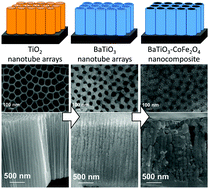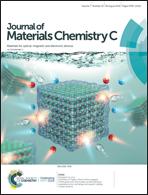Nanotube array-based barium titanate–cobalt ferrite composite film for affordable magnetoelectric multiferroics†
Abstract
Magnetoelectric multiferroic nanocomposites are increasingly attracting attention from researchers and engineers due to their transformative technological potential. Many papers have so far reported a fundamental understanding and designs of new multiferroic nanocomposites, and their potential applications. However, many challenges for establishing and expanding their applications remain, for example, the development of an affordable fabrication process for nanocomposites which show room temperature multiferroics with robust coupling between ferroelectricity and magnetism is one of the highest demands. In this work, an affordable liquid phase based method to fabricate a magnetoelectric multiferroic nanocomposite film is reported. Ferroelectric BaTiO3 (BTO) nanotube arrays are fabricated via anodization and hydrothermal treatment, and then spin-coated with ferrimagnetic CoFe2O4 (CFO) to obtain a BTO–CFO nanocomposite film. The film exhibits not only room-temperature multiferroicity but also perpendicular magnetic anisotropy.



 Please wait while we load your content...
Please wait while we load your content...